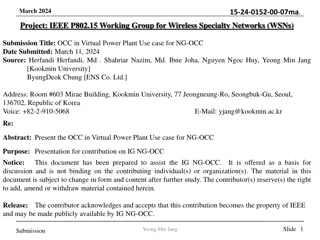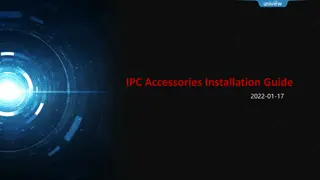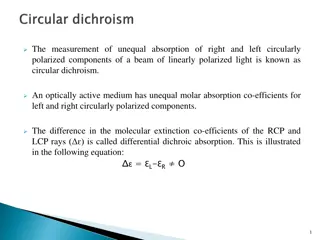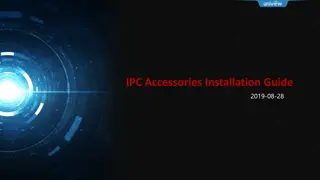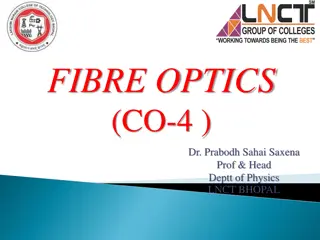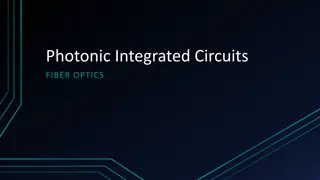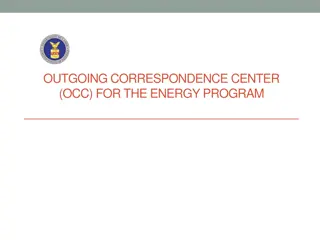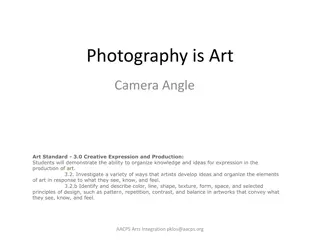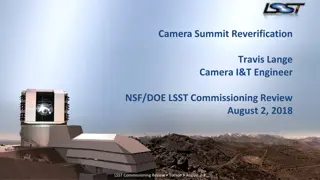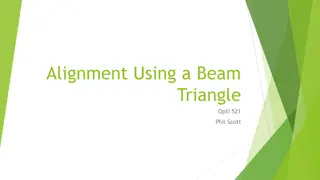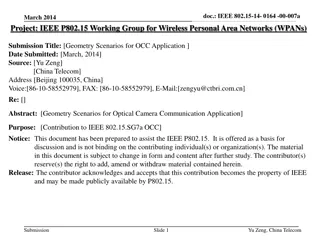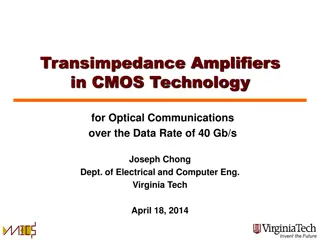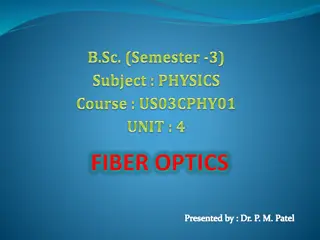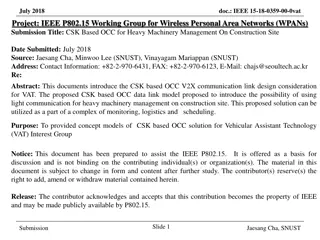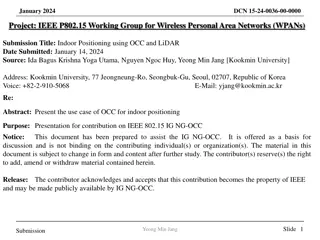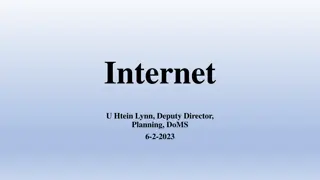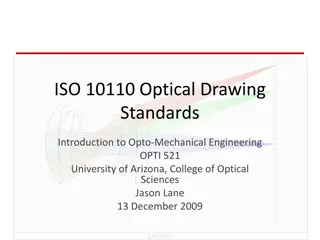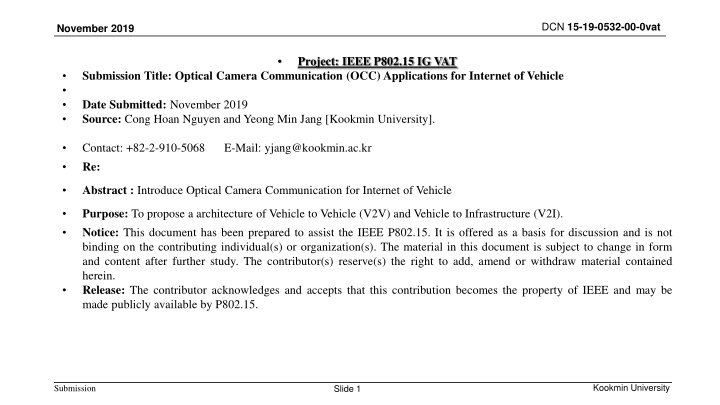
Innovative Optical Camera Communication Applications for Internet of Vehicles
Explore the potential of Optical Camera Communication (OCC) in revolutionizing Internet of Vehicles (IoV). This cutting-edge technology enables seamless communication between vehicles, infrastructure, sensors, and personal devices, enhancing road efficiency and safety. Discover how OCC, a part of optical wireless communication, offers advantages over traditional RF methods and is being widely researched and implemented in various vehicular communication scenarios. Learn about the architecture of Vehicle-to-Everything (V2X) communication and the diverse applications of OCC in digital signage, localization, distance measurement, and more.
Download Presentation

Please find below an Image/Link to download the presentation.
The content on the website is provided AS IS for your information and personal use only. It may not be sold, licensed, or shared on other websites without obtaining consent from the author. If you encounter any issues during the download, it is possible that the publisher has removed the file from their server.
You are allowed to download the files provided on this website for personal or commercial use, subject to the condition that they are used lawfully. All files are the property of their respective owners.
The content on the website is provided AS IS for your information and personal use only. It may not be sold, licensed, or shared on other websites without obtaining consent from the author.
E N D
Presentation Transcript
DCN 15-19-0532-00-0vat November 2019 Project: IEEE P802.15 IG VAT Submission Title: Optical Camera Communication (OCC) Applications for Internet of Vehicle Date Submitted: November 2019 Source: Cong Hoan Nguyen and Yeong Min Jang [Kookmin University]. Contact: +82-2-910-5068 Re: E-Mail: yjang@kookmin.ac.kr Abstract : Introduce Optical Camera Communication for Internet of Vehicle Purpose: To propose a architecture of Vehicle to Vehicle (V2V) and Vehicle to Infrastructure (V2I). Notice: This document has been prepared to assist the IEEE P802.15. It is offered as a basis for discussion and is not binding on the contributing individual(s) or organization(s). The material in this document is subject to change in form and content after further study. The contributor(s) reserve(s) the right to add, amend or withdraw material contained herein. Release: The contributor acknowledges and accepts that this contribution becomes the property of IEEE and may be made publicly available by P802.15. Kookmin University Submission Slide 1
DCN 15-19-0525-00-0vat November 2019 Optical camera communication (OCC) applications for Internet of Vehicle (IoV) Submission Slide 2 Kookmin University
DCN 15-19-0532-00-0vat November 2019 Introduction The increasing number of things are demanding a new global framework through the connection and combination of all the existing heterogeneous networks. These various things shaped as Internet-of-things (IoT) are being used widely in our daily life, such as smart devices in the hand of everyone, smart home, tablets and laptops in everywhere, vehicles and traffic lights in roads, and other devices connected to sensors. Most of the portion of IoT will be covered by vehicles in the near future which has been termed as internet of vehicles (IoV). Submission Slide 3 Kookmin University
DCN 15-19-0532-00-0vat November 2019 Introduction The main parts of IoV consist of communication between vehicle-to-vehicle (V2V), vehicle-to- infrastructure (V2I), vehicle-to-cloud (V2C), vehicle-to-sensors (V2S), and vehicle-to-personal devices (V2P). This whole system can be defined as vehicle-to everything (V2X) communication. A general architecture of V2X is illustrated in figure Many technologies have been proposed and used to provide IoV services which include Bluetooth, Zigbee, Wi-Fi, ultra-wideband, and etc. However, having massive possibility to address road efficiency and safety, these technologies are not attracting considerable attention in both academia and industries. Submission Slide 3 Kookmin University
DCN 15-19-0532-00-0vat November 2019 Introduction Optical camera communication (OCC), part of optical wireless communication, is developing in many new research and development areas due to its advantages over radio-frequency (RF). OCC comprise of light emitting diodes (LED) for transmitting the data which acts as transmitter (Tx) and image sensor (camera) for receiving the information from the LEDs which is defined as receiver (Rx). OCC has been used in many vehicular communications scenario in both industry and academy. This proves the feasibility and possibility of OCC scheme in V2X communication. OCC has also been used in many application, such as digital signage, localization, ToF based distance measurement, and etc. Submission Slide 5 Kookmin University
DCN 15-19-0532-00-0vat November 2019 OCC Architecture The Tx transmits information by modulating the lights at a very high frequency so that human eye cannot perceive the difference between the modulated signal and the original signal with no information. As a consequence, OCC Tx can provide communication and illumination functionalities simultaneously without any interruption. On the other hand, OCC receiver comprised of an image sensor or a pair of image sensors receives information transmitted form the Tx. a decoder or demodulator decode and process the previously modulated signal by converting into the electrical signal. From the electrical signal it can be easily decode the broadcast information Submission Slide 5 Kookmin University
DCN 15-19-0532-00-0vat November 2019 Proposed Architecture for OCC based IoV Figure represents the vehicular communication mechanism using OCC for V2V and V2I communication. OCC uses vehicle backlight LED lights or traffic lights as Tx and camera (webcam or high-speed camera) as Rx. Here, the Tx (traffic light or vehicles rear LEDs) transmit the vehicles status (speed, safety information, emergency message, and etc.) or the traffic condition. Then, the receiver can be a single or pair of image sensor which receives the transmitted information from the Tx. Submission Slide 5 Kookmin University
DCN 15-19-0532-00-0vat November 2019 Proposed Architecture for OCC based IoV Figure represents the flow sequence for the proposed OCC based IoV system. We categorized the whole system into four phases: i) information acquisition, ii) pre-processing, iii) communication, and iv) server. Submission Slide 5 Kookmin University
DCN 15-19-0532-00-0vat November 2019 Conclusion We described the OCC principle with the descriptions of OCC transmitter and receiver. Then, we described the proposed IoV scheme based on OCC and cloud server concept. The main contributions of this research consist of i) designing an OCC based V2X communication system, ii) presenting cloud server concept in conjunction with OCC that has not yet been proposed by anyone in the world. Finally, we have proposed an algorithm to demonstrate the performance of our proposed IoV system. The future studies include implementation of the proposed algorithm in the real vehicular scenario and ensure a more reliable communication system. Submission Slide 5 Kookmin University
DCN 15-19-0532-00-0vat November 2019 References [1]T. Nguyen, A. Islam, M. T. Hossan, and Y. M. Jang, Current Status and Performance Analysis of Optical Camera Communication Technologies for 5G Networks, IEEE Access, vol. 5, no. , pp. 4574-4594, 2017. [2]A. Islam, M. A. Hossain, T. Nguyen, and Y. M. Jang, High temporal spatial resolution optical wireless communication technique using image sensor, in Proc. of 2016 International Conference on Information and Communication Technology Convergence (ICTC), Jeju, 2016, pp. 1165- 1169. Submission Slide 7 Kookmin University

